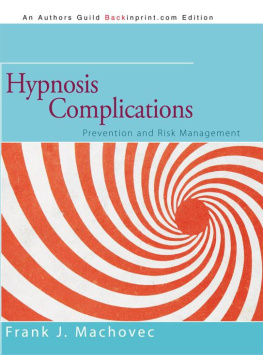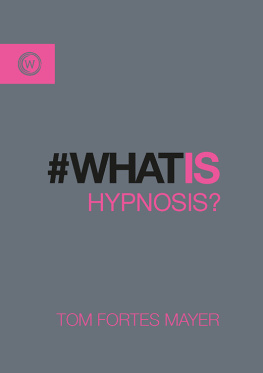Frank J. Machovec - Hypnosis Complications: Prevention and Risk Management
Here you can read online Frank J. Machovec - Hypnosis Complications: Prevention and Risk Management full text of the book (entire story) in english for free. Download pdf and epub, get meaning, cover and reviews about this ebook. year: 2012, publisher: iUniverse, genre: Religion. Description of the work, (preface) as well as reviews are available. Best literature library LitArk.com created for fans of good reading and offers a wide selection of genres:
Romance novel
Science fiction
Adventure
Detective
Science
History
Home and family
Prose
Art
Politics
Computer
Non-fiction
Religion
Business
Children
Humor
Choose a favorite category and find really read worthwhile books. Enjoy immersion in the world of imagination, feel the emotions of the characters or learn something new for yourself, make an fascinating discovery.
- Book:Hypnosis Complications: Prevention and Risk Management
- Author:
- Publisher:iUniverse
- Genre:
- Year:2012
- Rating:5 / 5
- Favourites:Add to favourites
- Your mark:
- 100
- 1
- 2
- 3
- 4
- 5
Hypnosis Complications: Prevention and Risk Management: summary, description and annotation
We offer to read an annotation, description, summary or preface (depends on what the author of the book "Hypnosis Complications: Prevention and Risk Management" wrote himself). If you haven't found the necessary information about the book — write in the comments, we will try to find it.
Hypnosis Complications: Prevention and Risk Management — read online for free the complete book (whole text) full work
Below is the text of the book, divided by pages. System saving the place of the last page read, allows you to conveniently read the book "Hypnosis Complications: Prevention and Risk Management" online for free, without having to search again every time where you left off. Put a bookmark, and you can go to the page where you finished reading at any time.
Font size:
Interval:
Bookmark:
HYPNOSIS
COMPLICATIONS
Prevention and Risk Management
By
FRANK J. MACHOVEC, PH.D., A.B.P.H.
AN A UTHORS G UILD BACKINPRINT. COM E DITION
iUniverse, Inc.
Bloomington
HYPNOSIS COMPLICATIONS
Prevention and Risk Management
All Rights Reserved 1986, 2012 by Frank J. Machovec.
No part of this book may be reproduced or transmitted in any form or by any means, graphic, electronic, or mechanical, including photocopying, recording, taping, or by any information storage or retrieval system, without the written permission of the publisher.
AN AUTHORS GUILD BACKJNPRINT.COMEDITION
Published by iUniverse, Inc.
For information address: iUniverse
1663 Liberty Drive Bloomington, IN47403 www.iuniverse.com
1-800-Authors (1-800-288-4677)
Originally published by Charles C Thomas Publisher
Because of the dynamic nature of the Internet, any Web addresses or links contained in this book may have changed since publication and may no longer be valid.
The views expressed in this work are solely those of the author and do not necessarily reflect the views of the publisher, and the publisher hereby disclaims any responsibility for them.
Any people depicted in stock imagery provided by Thinkstock are models, and such images are being used for illustrative purposes only. Certain stock imagery Thinkstock.
ISBN: 978-1-4759-6003-7 (sc)
ISBN: 978-1-4759-6951-1 (ebk)
iUniverse rev. date: 12/04/2012
CONTENTS
Frank MacHovec has B.A., M.A. and Ph.D. degrees in psychology and is a clinical psychologist licensed in Virginia, North Carolina and Manitoba, Canada. He received his initial training and experience in hypnosis in 1970 from Michael M. Miller, M. D., author of Therapeutic Hypnosis, then 1973-1975 with F. L. Marcuse, author of Hypnosis: Fact and Fiction and Hypnosis Throughout the World. He was Chairman of the Ethics Committee, Vice President, then President of the Manitoba Hypnosis Society. He has attended advanced seminars in clinical hypnosis in 1978, 1979 and 1981 at the Southern California Society for Clinical Hypnosis and served as faculty at an annual conference of that society. He has taught the Psychology of Hypnosis at the University of Lethbridge in Alberta Canada.
He has served as Chairman, Secretary or as a member of ethics committees of professional associations in Manitoba, Canada, and in Alaska and Virginia. In 1981 he was awarded a Diplmate in Clinical Hypnosis by the American Board of Psychological Hypnosis. He is a member of the Society for Clinical and Experimental Hypnosis and the International Society of Hypnosis. In 1982 he was awarded a National Certificate of Recognition by the Division of Psychologists in Public Service of the American Psychological Association for his work in establishing ethical standards for hypnosis in Alaska. He has presented at state, regional, national and international conferences on the need for more care and higher ethical standards in the use of hypnosis.
In 1984 he chaired a committee to draft proposed restrictive legislation to control the practice of hypnosis in Virginia. The same year he founded the Center for the Study of the Self, a nonprofit clearinghouse for research and case material on hypnosis complications available to all the professions. In 1985 he presented on hypnosis complications at the 10th International Congress on Hypnosis and Psychosomatic Medicine in Toronto, Canada. The response to his talk there was so favorable that he further researched the subject, adding to his original material, resulting in the present volume.
. as with any treatment, no harm to the patient.
Hippocrates
To Evelyn, for her patience (and proofreading!), Jacquie and Frank for putting me up (and putting up with me!) and to Allison who re-educates us all about life and love.
My thanks to the late Michael M. Miller for hours of instruction and supervision, Andrew Salter for precious moments of inspiration and sound advice, Fred Marcuse for his gentle warmth and humor, and to Michael J. Rostafinski, M.D., consultant, colleague and friend for IV feeding (information validation) in the final hours of this endeavor.
I N 1970, when I first learned of hypnosis from Michael Miller,
M.D., careful and methodical graduate of the University of Vienna, himself taught by Freud, there was little concern about complications. Hypnosis was safe. During the next sixteen years, in my own practice, at conferences (especially chats before and after formal sessions), in case consultation, teaching, and on three ethics committees in the U. S. and Canada, I learned of many horror stories, of unexpected problems from a few moments of minor discomfort to some really serious medical and psychiatric emergencies which persisted for days and weeks. Hypnosis is not as safe as many of us have been taught. Complications are under-reported and underestimated in type and frequency.
This book is written for clinicians and researchers and for interested consumers who want to know more about hypnosis and adequate standards of care for its use. Research methodology and theoretical issues are avoided except as they relate to complications. The goal was to provide a convenient, practical source of information on risk management and preventive practices to avoid the problems here, taken from several decades of books and journal articles and the authors own personal and professional journey from false security to cautious awareness.
It is expected some will criticize this work for its lack of detail in case descriptions, too few statistical analyses, and reliance on anecdotal records. These are justified criticisms! They point up the need for more data. We need more detail about what can go wrong. A suggested complications report form is included as an appendix to this book. The lack of data made it difficult to evaluate risk factors. Sixteen years of experience using hypnosis was a great help. Adding to this difficulty is the unfortunate fact that most published theorists and clinicians report few failures. There is little research based on large numbers of subjects and what there is relies heavily on college student volunteers, usually psychology majors on campus, not clinically the real world.
Clinicians may be concerned, perhaps defensive, to read of potential danger from techniques they use routinely (and without apparent ill effect) and which they have been assured are safe. They may believe, like combat soldiers, it wont ever happen to me. Regrettably, it does happen to someone. They may feel unwanted side effects would happen anyway even without hypnosis. It is sometimes difficult to separate what belongs to hypnosis and what belongs to therapy (J. Hilgard, 1974, p. 282). The unhappy fact is that every problem cited here coincided with the use of hypnosis and did not occur at any other time. The vast majority of casualties had no prior history of referral for or treatment of mental problems. The conclusion is inescapable: there was something about hypnosis or the subjects mental state before and during hypnosis that precipitated complications (possibly both).
Some may feel that dwelling only on complicatons is misleading and exaggerates what are really minimal risk factors. Few successes are reported here because of the books focus. I have used hypnosis sixteen years and intend to continue to do so, but not as I was taught it. Automobile and air travel are safe despite the accident rate. So also for hypnosis, except there is no accident prevention program for hypnosis and there should be. This book is an attempt to provide the basis for an effective program of risk management, to help clinicians and researchers integrate preventive practices into their work as standard practice. It is an appeal to all who use hypnosis to be more aware of potential problems, to be more careful and more caring.
Next pageFont size:
Interval:
Bookmark:
Similar books «Hypnosis Complications: Prevention and Risk Management»
Look at similar books to Hypnosis Complications: Prevention and Risk Management. We have selected literature similar in name and meaning in the hope of providing readers with more options to find new, interesting, not yet read works.
Discussion, reviews of the book Hypnosis Complications: Prevention and Risk Management and just readers' own opinions. Leave your comments, write what you think about the work, its meaning or the main characters. Specify what exactly you liked and what you didn't like, and why you think so.








